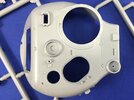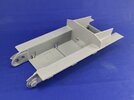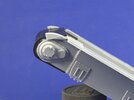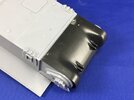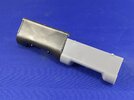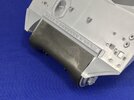I hope you'll enlighten us as to the nuance that makes it an M4A2
Since my kit hasn’t arrived yet (not too surprising, I ordered it yesterday and I would be very surprised to get it delivered on a Sunday anyway), let’s start with the background information.
The Medium Tank M4, later to be better known as the
Sherman, after its British name, was developed in the USA in 1941 on the basis of the Medium Tank M3 (“Lee” and “Grant” to the British, depending on the exact version). That itself was an interim tank based on the Medium Tank M2 (no nickname — nobody would have wanted that tank in a shooting war anyway) to get a well-armed tank in production while a better one (the M4) was being designed.
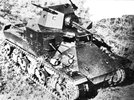
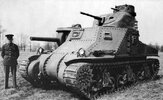
The first photo is an M2, the other is an M3. On the M2, note the overabundance of machine guns, while on the M3, those have been toned down but the 75 mm main gun is in an awkward location. The M4 fixed all of that:
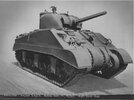
It was a modern design, with a good gun and good armour for the time, as well as being easy to maintain. Its primary drawbacks were its so-so suspension that didn’t provide a very good ride (but not too bad either), its very tall engine (because it used a radial aircraft engine) that lead to a tall hull, and the complicated way the hull front was built up, which lead to it being relatively weak. The M4 had a hull welded from rolled plates and castings, though the details of this vary per manufacturer, and a cast turret. As an alternative, a fully cast upper hull was designed as well and standardised as the M4A1. If you see a Sherman with smooth lines rather than an angular upper hull, it will be an M4A1 — but only if the whole upper hull is cast, else it’s a late-production M4 which had a cast front but welded middle and rear parts of the upper hull (or possibly an M4A6, but only 75 of those were built, out of a total of 49,234 Shermans made from early 1942 through the autumn of 1945).
The choice of engine proved to be a problem once war production really began to ramp up, because aircraft radial engines obviously had other uses than powering tanks. It had been chosen because aircraft engines are both powerful and compact, which is useful for a tank as well, but even during production of the M3 it became obvious that alternative engines would be needed if enough tanks were to be built. Several variants of the M3 appeared with different engine fits, and because the M4’s lower hull — everything from the upper run of the tracks down — was essentially identical to the M3, it was easy enough to adapt the M4 to these engines too.
The first alternative engine was from General Motors, model number 6046. This brings us to the fact that the Sherman’s official designation basically tells you which engine each variant uses:
- M4: Continental R975 9-cylinder radial petrol
- M4A1: Continental R975 9-cylinder radial petrol
- M4A2: GM 6046 12-cylinder (twin 6-cylinder) diesel
- M4A3: Ford GAA V8 petrol
- M4A4: Chrysler A57 30-cylinder (five 6-cylinder) petrol
- (M4A5: Continental R975 9-cylinder radial petrol — though this is not a Sherman but the American designation for the Canadian Ram Cruiser Tank that was developed separately from the M3, in parallel to the M4)
- M4A6: Ordnance Engine RD-1820 9-cylinder radial diesel
Here, we’re talking about the M4A2:
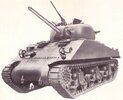
Its GM 6046 consisted of two six-cylinder inline diesel engines side-by-side on a common crankcase, and necessitated a change in the engine deck to give it enough air. Compare the engine decks in these pictures:
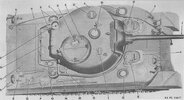
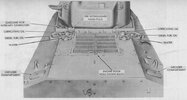
The first is an M4 (with the cast hull front), which has a large lid directly behind the turret; this covers the air intake. The second photo has a grill there instead, which also extends further back on the engine deck. This grill is the primary recognition point for an M4A2: if you can see the engine deck, look for this type of grill and you know there is a GM twin diesel underneath.
As an aside, though,
just the presence of a grill is not enough to ID an M4A2, because the M4A3 had one as well:
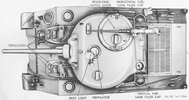
You need to look at the size of the grill too: the M4A2’s is about half the width of the engine deck while the M4A3’s is the full width (and it’s set a little further back on the engine deck).
The other good way to tell Sherman variants apart is if you can see the rear of the lower hull. The different engine types had different access doors on the rear plate, and easiest of all is out subject here, the M4A2: this had two horizontal mufflers, usually with a curved plate in front of them. If you can see that, you are 100% certain looking at an M4A2, because none of the other variants had external mufflers.
From the front, the difference between the M4, M4A2, M4A3 and M4A4 is very hard to tell unless you really know what details to look for — and even then it’s frequently impossible to say exactly.
Now, as I said, one of the chief problems of the Sherman was the way its glacis plate was fabricated. This photo from
the Sherman Minutia web site (and it happens to be an early M4A2) shows it very well:
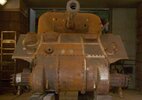
The bright lines are welds (except on the horizontal bit with the five bolt holes and everything below that), and though the exact build-up varied per manufacturer, they were all essentially similar to this: several different plates, welded together into a single glacis plate. This was rather weaker than a single plate would have been, so quite why it was designed like this beats me.
A second problem was the hatches for the driver and his assistant, which were set in a little protruding bay, and that presented a vertical face to the enemy which made them weak spots as well. Experience also showed the hatches to be on the small side, making escape difficult for the crew. (Among Sherman aficionados, tanks with these are known as “small hatch” versions.)
The solution was to redesign the whole front of the tank:
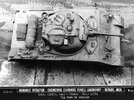
The hull front was now one single plate, with just a hole in it for the bow machine gun, and the hatches were made larger and set diagonally instead of straight. The revised hatches necessitated that the front plate was less sloped, but it was also thickened from 51 mm to 64 mm to compensate. (The M4A1 as well as the M4 with cast front were similarly redesigned.)
As part of this redesign, other modifications were also made. You may notice in the last picture above that there is a second hatch on the turret roof, that all the previous ones shown lack. This is because escape proved difficult for the loader, who had to duck under the gun and then go up and out through the commander’s hatch, so he was given his own hatch to increase his chances of survival.
Internally, major changes were made as well. Up until the redesign, Shermans had had most of their ammunition stowed in the sponsons (the parts of the hull overhanging the tracks). This proved to be a very vulnerable location, because this is the part that was most easily hit by enemy fire, and a penetrating round would then hit the ammunition — splitting cases and spilling propellant everywhere, which then frequently ignited. Contrary to popular belief, fires in tanks are not usually caused by its fuel, but rather, by the ammunition being hit. The first fix was to weld plates on the outside of the hull, over the ammo racks, and also add thin armour plates over the racks on the inside. This was done both by army workshops on tanks already delivered, as well as by factories overhauling existing tanks and in factories building new tanks.
The real solution, though, was to redesign the inside of the tank, which went hand-in-hand with the revised glacis plate. This moved all ammunition stowage to the hull floor, where it was very much less likely to be hit; these new stowage bins were double-walled, with a water–antifreeze mixture in the space between the walls so that if the bin as penetrated, it would flood the bin and smother propellant fires. As a result, Shermans with these bins are known as “wet stowage” and the earlier type as “dry stowage”. Tanks with wet stowage never have the additional armour plates on the hull sides — with which
Tamiya put generations of modellers building the old
Tamiya M4A3 on the wrong foot

That kit includes the plates as an optional extra, when no tank of the type portrayed by the kit ever had them. However, a few hundred M4A2 tanks were built with the revised glacis plate but dry stowage ammo racks. This is probably the cause of
Tamiya’s mistake, because as said, from the front the difference between an M4A2 and A3 is very hard to tell.
All this brings us to the Zvezda kit: that is of an M4A2 and includes the extra armour plates, meaning it can be built as one of the pretty rare M4A2 “dry” tanks. (By leaving off the armour plates, you can also build it as a slightly later tank with wet stowage, of course.)
Now, why is it a Soviet tank? Quite simply because the USA supplied the USSR with large numbers of M3 and M4 medium tanks during the war, under the Lend-Lease Act. The Soviets wanted diesel-engined tanks, because all their own tanks used diesel engines, and the only diesel Sherman available as the M4A2, so the majority of those went to the USSR and were used from (I think) late 1943 until the end of the war. M4A2’s were also used by the UK, France and the US Marine Corps, but rarely by the US Army, which preferred first the M4 and M4A1, and later the M4A3.
After the war, the USSR returned the surviving tanks to the USA, as per the requirements of Lend-Lease (which stipulated that the equipment supplied remained US property and had to be returned if possible). The tanks were generally loaded up onto American ships in the Russian Far East, the ships would sail away, and once in international waters … dump the unwanted tanks overboard into the Pacific Ocean …















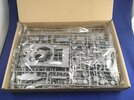
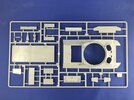
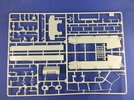
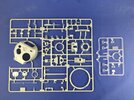
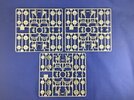
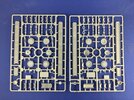
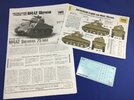
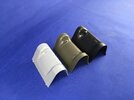
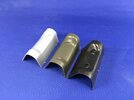
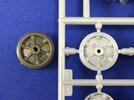
 I may have to go find photos of Soviet M4A2s with different styles of roadwheel …
I may have to go find photos of Soviet M4A2s with different styles of roadwheel …